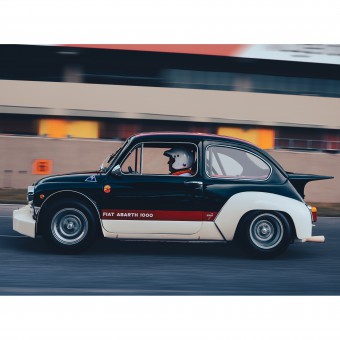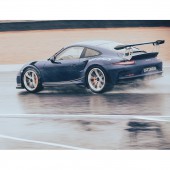
| THE AWARD |
| CATEGORIES |
| REGISTRATION |
| SUBMIT YOUR WORK |
| ENTRY INSTRUCTIONS |
| TERMS & CONDITIONS |
| PUBLICATIONS |
| DATES & FEES |
| METHODOLOGY |
| CONTACT |
| WINNERS |
| PRESS ROOM |
| GET INVOLVED |
| DESIGN PRIZE |
| DESIGN STORE |
| THE AWARD | JURY | CATEGORIES | REGISTRATION | PRESS | WINNERS | PUBLICATIONS | ENTRY INSTRUCTIONS |
Moments of Speed Photographs by Martin Hoffmann |
Home > Winners > Design #158638 >Interview |
 |
|
FS: What is the main principle, idea and inspiration behind your design?
MH: The idea behind "Moments of Speed" is that in these photos, fleeting time suddenly transforms into a calm moment. The tension of the fast moment is reversed into the relaxation of contemplation. The transience of movement pauses in the picture, suddenly radiating calm.
FS: What has been your main focus in designing this work? Especially what did you want to achieve?
MH: Speed and movement unfold an almost contradictory effect in the photos. The strength lies in the transformation of fleeting time into a calm moment. The speed seems to stand still, free for relaxed contemplation. Although details, sharpness and blurring resulting from the speed create their own drama, lending the static image permanent dynamism, the interesting feature is the creation of a simultaneously contradictory effect: an image that radiates calm in all the movement.
FS: What are your future plans for this award winning design?
MH: The pictures will be presented as a new highlight in my customer's racing collection. The images are currently being incorporated into my website. In order to emphasise and promote the quality of my work as an award-winning reference. Furthermore, the work is presented on LinkedIn in my own presentation and can be accessed there. I am also planning publication in other media.
FS: How long did it take you to design this particular concept?
MH: The idea came from my desire to present or rearrange racing situations in a different context. The preliminary considerations arose successively in the run-up to the event days. I depicted situations with other sections or perspectives that could suitably represent my idea. These experiments took place on site within a few days at various other events with suitable framework conditions.
FS: Why did you design this particular concept? Was this design commissioned or did you decide to pursuit an inspiration?
MH: In racing photos, you often see similar depictions that can no longer necessarily capture the viewer's interest. How can the same motifs be presented in a new way? The goal: to find a new, different visualisation. So I developed the idea of depicting the speed that is made visible in these situations in such a way that the viewer suddenly develops a different image through the composition, the surroundings and the colour scheme. An image that radiates calm and relaxation in the driving situation pictured. The pictures were part of a commissioned work.
FS: Is your design being produced or used by another company, or do you plan to sell or lease the production rights or do you intent to produce your work yourself?
MH: This point has to be discussed with the client.
FS: What made you design this particular type of work?
MH: Creativity in photography. Presenting things differently and achieving new effects.
FS: Where there any other designs and/or designers that helped the influence the design of your work?
MH: My late brother, an excellent photographer and filmmaker, was my role model. Also with the thesis, leave out everything that is not needed so that people see what you want them to see.
FS: Who is the target customer for his design?
MH: Motorsport fans and customers of my client.
FS: What sets this design apart from other similar or resembling concepts?
MH: A different interpretation of the depiction of speed. The result is an image of calm in all the movement. Details, sharpness and blurring resulting from the speed create their own drama, lending the static image a permanent dynamic. The image detail, elements of the immediate surroundings, lighting and contrast as well as the choice and reduction of colours create a suitable mood.
FS: How did you come up with the name for this design? What does it mean?
MH: Moments of Speed? A constant moving situation, which can only be perceived as blurred, shaky or shadowy as it passes by, becomes a frozen, stable image document - a moment.
FS: Which design tools did you use when you were working on this project?
MH: Live shots at the race track. Camera Canon EOS 7D MkII, lenses Canon EF 24-105 f/4L IS, Canon EF 70-200 f/2.8L IS USM. Gopro Hero 11, post-processing with Adobe Lightroom (corrections, presets) and Photoshop if necessary.
FS: What is the most unique aspect of your design?
MH: The effect achieved in two stages. Firstly, the foreground depiction of a moving object and, in the second view, the transformation of the depicted speed into a moment of calm.
FS: Who did you collaborate with for this design? Did you work with people with technical / specialized skills?
MH: Together with a technician, the GoPro was positioned and attached to the vehicle. This ensured that the camera could not come loose unintentionally or impair the driving characteristics.
FS: What is the role of technology in this particular design?
MH: Post-processing in Lightroom with the appropriate presets and fine-tuning the details creates an image effect that makes every picture appear even deeper, more intense and more harmonious.
FS: Is your design influenced by data or analytical research in any way? What kind of research did you conduct for making this design?
MH: In post-processing, tests were carried out with various colour options, depths and presets in order to develop exactly the right profile to best bring out the ideal mood of the respective image.
FS: What are some of the challenges you faced during the design/realization of your concept?
MH: Due to imponderables and unforeseen circumstances, such as changes in the weather situation, the light or the organiser's planning, it is often necessary to react quickly. These moments are sometimes difficult to repeat. Adjusting to new situations immediately and giving 100% commitment, making the right decisions. Be it the choice of camera, lens, camera settings, angle of view, location.
FS: How did you decide to submit your design to an international design competition?
MH: After my client was impressed by the photographs presented, I decided to enter them in the competition. I had already won a bronze award at the A' Design & Competition last year in Graphics Design category and thought I would give these photographs a try.
FS: What did you learn or how did you improve yourself during the designing of this work?
MH: The approach has actually confirmed my work ethic: It is important to always stay on the ball, to test new ways, to push the boundaries. Even if difficulties arise, to overcome them. To further optimise your own work and only be satisfied with the best result.
FS: Any other things you would like to cover that have not been covered in these questions?
MH: Winning an award is a great motivational boost and a sign of appreciation for a creative person. In normal everyday life, you often question your work and take a very critical view of yourself. So it's a really good feeling to receive this award.
FS: Thank you for providing us with this opportunity to interview you.
A' Design Award and Competitions grants rights to press members and bloggers to use parts of this interview. This interview is provided as it is; DesignPRWire and A' Design Award and Competitions cannot be held responsible for the answers given by participating designers.
| SOCIAL |
| + Add to Likes / Favorites | Send to My Email | Comment | View Press-Release |




